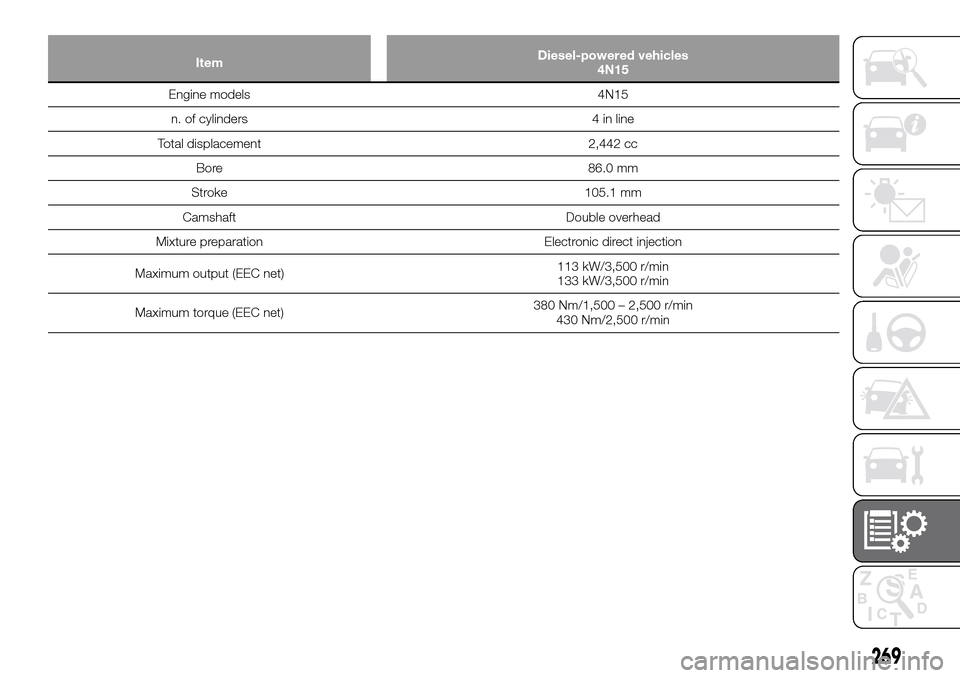torque FIAT FULLBACK 2016 1.G User Guide
[x] Cancel search | Manufacturer: FIAT, Model Year: 2016, Model line: FULLBACK, Model: FIAT FULLBACK 2016 1.GPages: 312, PDF Size: 13.67 MB
Page 201 of 312

NOTE Confirm that the hanger disc is
securely fitted in the wheel disc hole
when the wheel is just lifted off the
ground.
3. After winding up the spare wheel
sufficiently, make sure it is not loose (the
tightening torque should be
approximately 40 Nm (achieved by
applying a force of 200 N at the end of
the wheel nut wrench) then withdraw
the jack handle, taking care not to turn
it in the reverse direction.
278) 279) 280)
4. Have your damaged tyre repaired as
soon as possible.
To store the tools, jack and jack
handle
Reverse the removing procedure when
storing the jack, jack handle and wheel
nut wrench (refer to “Tools, jack and
jack handle”).
WARNING
257)Use your hazard lights, warning
triangle, etc. to show that your vehicle is
stationary according to the regulations in
force. Passengers should get out of the
vehicle, particularly if it is heavily loaded,
and wait for the wheel to be changed away
from the traffic. Apply the handbrake. in the
event of a wheel change on a slope or on
unsurfaced roads, put any object as stop
under the wheels.
258)Be sure to apply chocks or blocks to
the correct tyre when jacking up the
vehicle. If the vehicle moves while jacked
up, the jack could slip out of position,
leading to an accident.
259)The pressure should be periodically
checked and maintained at the specified
pressure while the tyre is stowed. Driving
with an insufficient tyre pressure can lead
to an accident. If you have no choice but to
drive with an insufficient tyre pressure,
keep your speed down and inflate the tyre
to the correct pressure as soon as
possible. (Refer to “Tyre inflation
pressures”).
260)Set the jack only at the positions
shown here. If the jack is set at a wrong
position, it could dent your vehicle or the
jack might fall over and cause personal
injury.
261)Do not use the jack on a tilted or soft
surface. Otherwise, the jack might slip and
cause personal injury. Always use the jack
on a flat, hard surface. Before setting the
jack, make sure there are no sand or
pebbles under the jack base.262)Stop jacking up the vehicle as soon
as the tyre is raised off the ground. It is
dangerous to raise the vehicle any higher.
Do not get under your vehicle while using
the jack. Do not bump the raised vehicle or
leave it sitting on the jack for a long time.
Both are very dangerous. Do not use a jack
except the one that came with your
vehicle. The jack should not be used for
any purpose other than to change a tyre.
No one should be in your vehicle when
using the jack. Do not start or run the
engine while your vehicle is on the jack. Do
not turn the raised wheel. The tyres still on
the ground could turn and make your
vehicle fall off the jack.
263)Do not get under your vehicle while
using the jack.
264)Do not bump the raised vehicle or
leave it sitting on the jack for a long time.
Both are very dangerous.
265)Do not use a jack except the one that
came with your vehicle.
266)The jack should not be used for any
purpose other than to change a tyre.
267)No one should be in your vehicle
when using the jack.
268)Do not start or run the engine while
your vehicle is on the jack.
269)Do not turn the raised wheel. The
tyres still on the ground could turn and
make your vehicle fall off the jack.
270)Handle the wheel carefully when
changing the tyre, to avoid scratching the
wheel surface.
B
336AHA102319
199
Page 270 of 312

ENGINE SPECIFICATIONS
Engine specifications
344)
Item Petrol-powered vehicles
Engine models 4G64
n. of cylinders 4 in line
Total displacement 2,351 cc
Bore 86.5 mm
Stroke 100.0 mm
Camshaft Single overhead
Mixture preparation Electronic injection
Maximum output (EEC net) 97 kW/5,250 r/min
Maximum torque (EEC net) 202 Nm/4,000 r/min
268
TECHNICAL SPECIFICATIONS
Page 271 of 312

ItemDiesel-powered vehicles
4N15
Engine models 4N15
n. of cylinders 4 in line
Total displacement 2,442 cc
Bore 86.0 mm
Stroke 105.1 mm
Camshaft Double overhead
Mixture preparation Electronic direct injection
Maximum output (EEC net)113 kW/3,500 r/min
133 kW/3,500 r/min
Maximum torque (EEC net)380 Nm/1,500 – 2,500 r/min
430 Nm/2,500 r/min
269
Page 272 of 312

ItemDiesel-powered vehicles
4D56
Without intercoolerWith intercooler
Not for vehicles with 15 inch tyreWith intercooler
Vehicles with 15 inch tyre
Engine models 4D56
No. of cylinders 4 in line
Total displacement 2,477 cc
Bore91.1 mm
Stroke95.0 mm
Camshaft Double overhead
Mixture preparation Electronic direct injection
Maximum output (EEC net) 81 kW/4,000 r/min100 kW/4,000 r/min
131 kW/4,000 r/min
(1)94 kW/4,000 r/min
Maximum torque (EEC net)200 Nm/1,500
–3,500 r/min324 Nm/2,000 r/min
400 Nm/2,000 r/min
(1)240 Nm/1,500 – 3,500 r/min
(1) Vehicles with high power engine
344)
WARNING
344)Modifications or repairs to the fuel supply system that are not carried out properly or do not take the system’s technical specifications
into account may cause malfunctions leading to a risk of fire.
270
TECHNICAL SPECIFICATIONS